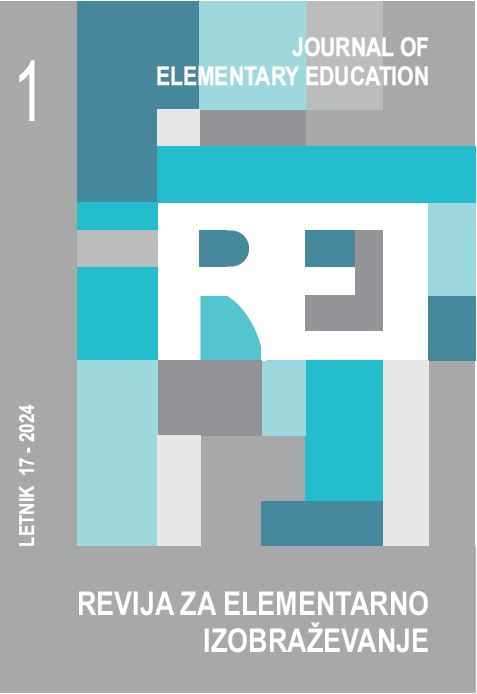Ovire pri prepoznavanju geometrijskih likov pri predšolskih otrocih
Povzetek
Raziskave kažejo, da imajo otroci, stari od 3 do 6 let, težave pri razumevanju koncepta geometrijskih likov. Osnovni cilj prispevka je preučiti intuitivno znanje otrok o trikotnikih in kvadratih. Analizirali smo vpliv distraktorjev (netipičnih lastnosti) na prepoznavanje likov in neupoštevane lastnosti protiprimerov. Namen raziskave je bil ugotoviti razvojne stopnje otrok pri prepoznavanju likov. Ugotavljali smo vrste distraktorjev in neupoštevane značilnosti pri prepoznavanju likov. Podatke, pridobljene z intervjuji, smo obdelali s statistično in deskriptivno kvalitativno analizo. Oblikovali smo klasifikacijo distraktorjev in značilnosti protiprimerov, ki vplivajo na prepoznavanje likov.
Prenosi
Literatura
Bernabeu, M., Llinares, S., and Salvador, S. (2019). The evolution of a 9-year-old students’ understanding of the relationship among geometrical shapes. Eleventh Congress of the European Society for Research in Mathematics Education. Netherlands: Utrecht.
Burger, W. F., and Shaughnessy, J. M. (1986). Characterizing the van Hiele levels of development in geometry. Journal for Research in Mathematics Education, 17, 31–48. https://doi.org/10.5951/jre-sematheduc.17.1.0031
Clements, D. H., and Battista, M. T. (1992). Geometry and spatial reasoning. In D. A. Grouws (Ed.), Handbook of research on mathematics teaching and learning, (pp. 420–464). New York: Macmillan.
Clements, D. H., Swaminathan, S., Hannibal, M., and Sarama, J. (1999). Young children’s concepts of shape. Journal for Research in Mathematics Education, 30(2), 192–212. https://doi.or-g/10.2307/749610
Clements, D. H., Sarama, J., and Joswick, C. (2018). Learning and teaching geometry in early childhood. Quadrante, 27(2), 7‒31. https://doi.org/10.48489/quadrante.22970
Đokić, O., and Zeljić, M. (2017). Teorije razvoja geeometrijskog mišljenja prema van Hilu, Fišbajnu i Udemon Kuzniaku [Theoretical frameworks in the development of geometrical thinking according to van Hiele, Fischbein and Houdement-Kuzniak]. Teme, 41(3), 623–637. https://doi.org/10.22190/TEME1703623D
Đokić, O., Jelić, M., and Ilić, S. (2020). The Correlation between Figural and Conceptual Properties of Angle and Cube in Pre-Service Teachers Geometric Reasoning. Teaching Innovations, 33(1), 1–20. https://doi.org/10.5937/inovacije2001001D
Fischbein, E. (1987). Intuition in science and mathematics. Dordrecht, the Netherlands: Reidel
Fischbein, E. (1993). The theory of figural concepts. Educational Studies in Mathematics, 24(2), 139–162. https://doi.org/10.1007/BF01273689
Hannibal (1999). Young children’s developing understanding of geometric shapes. Teaching Children Mathematics, 5(6), 353–357. https://doi.org/10.5951/TCM.5.6.0353
Hershkowitz, R. (1989). Visualization in geometry–two sides of the coin. Focus on Learning Problems in Mathematics, 11(1), 61–76.
Kellog, R. T. (1980). Feature frequency and hypothesis testing in the acquisition of rule-governed concepts. Memory & Cognition, 8(3), 297–303. https://doi.org/10.3758/BF03197618
Koleza, E., and Giannisi, P. (2013). Kindergarten children’s reasoning about basic geometric shapes. In B. Ubuz, C. Haser, and M. A. Mariotti (Eds.), Proceedings of the eighth congress of the European society for research in mathematics education. CERME 8. (pp. 2118–2127). Ankara: Middle East Technical University and ERME
Markman, E. (1988). Categorization and naming in children. Massachusetts: MIT.
Mitchelmore, M. C., and White, P. (2000). Development of angle concepts by progressive abstraction and generalization. Educational Studies in Mathematics, 41(3), 209–238. https://doi.or-g/10.1023/A:1003927811079
Piaget, J., Inhelder, B., Langdon, F. J., and Lunzer Trans, J. L. (1967). The child’s conception of space. New York: W. W. Norton.
Satlow, E., and Newcombe, N. (1998). When is a triangle not a triangle? Young children's developing concepts of geometric shape. Cognitive Development, 13(4), 547–559. https://doi.org/10.101-6/S0885-2014(98)90006-5
Tsamir, P., Tirosh, D., and Levenson, E. (2008). Intuitive non-examples: the case of triangles. Educational, Studies in Mathematics, 69(2), 81–95. https://doi.org/10.1007/s10649-008-9133-5
Tsamir, P., Tirosh, D., Levenson, E., Barkai, R., and Tabach, M. (2015). Early years teachers’ concept images and concept definitions: triangles, circles, and cylinder. ZDM: The International Journal on Mathematics Education, 47, 497–509. https://doi.org/10.1007/s11858-014-0641-8
Van Hiele, P. M. (1986). Structure and insight: A theory of mathematics education. Orlando, FL: Academic Press.
Waxman, S. R. (1999). The dubbing ceremony revisited: Object naming and categorization in infancy and early childhood. In D. L. Medin and S. Atran (Eds.), Folk Biology (pp. 233–284). Cambridge, MA: MIT Press/Bradford Books
Walcott, C., Mohr, D., and Kastberg, S. E. (2009). Making sense of shape: An analysis of children's written responses. The Journal of Mathematical Behavior, 28(1), 30–40. https://doi.org/1-0.1016/j.jmathb.2009.04.001
Wilson, S. (1986). Feature frequency and the use of negative instances in a geometric task. Journal for Research in Mathematics Education, 17, 130–139. https://doi.org/10.5951/jresematheduc.-17.2.0130
Štemberger, T. (2021). Statistical Significance and or Effect Size? Journal of Elementary Education, 14(4), 485–500. https://doi.org/10.18690/rei.14.4.485-500.2021
Žilkova, K., Partová, E., Kopácová, J., Tkačik, Š., Mokriš, M., Budínová, I., and Gunčaga, J. (2019). Young children's concepts of geometric shapes. London: Pearson.
Copyright (c) 2024 Marija Vorkapić, Jasmina Milinković Milinković, Mila Milošević Milošević

To delo je licencirano pod Creative Commons Priznanje avtorstva 4.0 mednarodno licenco.
